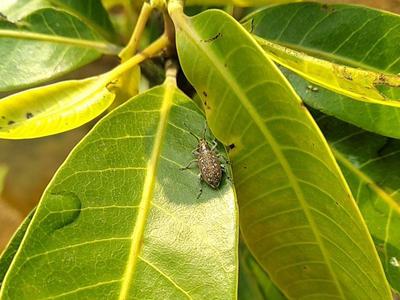Mango Nut Weevil
Sternochetus mangiferae
Insect
In a Nutshell
- Reddish-brown spots surrounded by water-soaked areas are visible on the fruits.
- Hardened, amber-colored secretion drop from these spots.
- Stones show holes and the inner core of the fruit turns into a black, rotten mass.
Can also be found in
Symptoms
Infected fruits are easily diagnosed because the insect wounds and punctures are visible on the peel as reddish-brown spots surrounded by water-soaked areas. These correspond to the site of egg deposition by females. Hardened, amber-colored secretions seem to drop from these areas. Larvae hatch and bore through the flesh to reach the seeds. Mango stones show holes and the interior core of the fruit may turn into a black, rotten mass. Infestation can result in early fruit drop and reduced germination capacity of seeds. In rare instances, for example in some late-maturing varieties, adults may exit the seed and tunnel through the fruit. This leaves scars on the fruit peel that attract secondary infections and ruins the fruit.
Recommendations

Organic Control
The ant Oecophylla smaragdina can be used as biocontrol agent against the adults. Hot and cold treatments can kill the insect at various stages of its development on fruits. Some viruses also affect the larvae of S. mangiferae.

Chemical Control
Always consider an integrated approach with preventive measures together with biological treatmetns if available. Successful control can be achieved by two sprays of deltamethrin, the first when fruits are 2-4 cm in size and the second 15 days later. Insecticide sprays based on several active ingredients are highly effective in preventing S. mangiferae infestations.
What caused it?
Adult mango nut weevil is an oval-shaped beetle with an elongated head that forms a snout. Female lay creamy-white, elliptical eggs singly on half mature (green) to ripe mango fruit. The puncture point is characterized by an incision on the fruit peel along with a light brown secretion. After 5-7 days, 1 mm long larvae hatch and tunnel through the flesh to reach the mango seeds. Usually, one larva is found feeding on each stone, sometimes up to 5. In some rare cases, the larvae will feed and pupate in the pulp. Adults usually emerge after fruits fall and undergo a period of suspended growth until new fruits appear on trees. When mangoes reach pea-size, they become active again and start feeding on leaves and mating. Long-range spreading of the bugs occurs through the transport of fruit, seeds, seedlings and/or cuttings containing larvae, pupae or adults.
Preventive Measures
- Collect seeds from healthy plants or from certified sources.
- Grow varieties with fruits resistant to penetration by larvae.
- Seeds may be shelled and inspected for possible damage.
- Dig the soil in direct vicinity of trees regularly to expose insect to predators.
- Remove scattered stones and fallen fruits from the ground.
- Bagging of fruits prevents bugs from depositing eggs.
- Be careful not to transport infested seeds or mango fruits to other areas.



